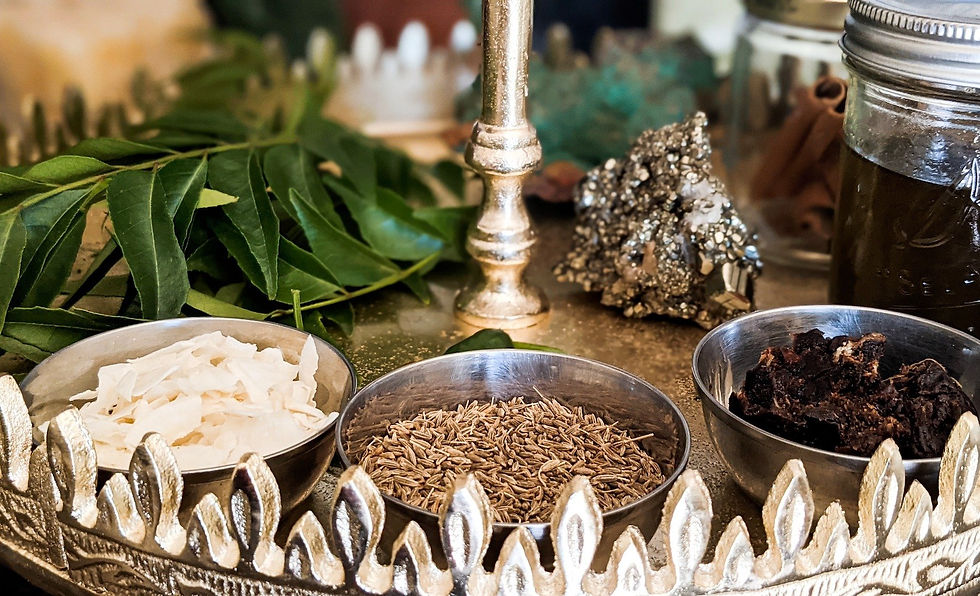Cannabis Infused Tamarind Rice (Bhang Khatta Bhaat): Collaboration with Allume
- YOGI MAHARAJ

- Oct 21, 2021
- 4 min read
Updated: May 11, 2022
Bhang is the Sanskrit word for cannabis. The tradition of cannabis was brought overseas from India to places such as Fiji, Trinidad, Tobago and Guyana, South Africa and Jamaica in the 1830’s when Indian farmers were sold as slave labor by Britain’s East India Trading Company. Although this led to the globalization of cannabis, these farmers are often written out of history.

Before taking ganja (another Sanskrit word for cannabis) to the Caribbean and beyond, India was home to thriving cannabis culture. Each region in South Asia had unique cultivation, harvesting and consumption techniques. The British quickly noticed this and began requiring farmers to obtain licenses to continue the cultivation of bhang. Some farmers refused and began creating their own legacy markets to distribute their harvest. To secure the weed trade, Britain decided to conduct detailed studies of farmers to monitor their harvests and growing techniques, which they reported back to England. The 3,698 page study is called The Indian Hemp Drug Commission Report of 1894. It's the largest scientific research on cannabis to date. The first seven volumes were released as a set, and the last volume, a “public study”, would be used to criminalize cannabis for centuries to come. This public study was used to discriminate against Asians who used the cannabis plant in British and French colonies overseas. “Coolies", or indentured slaves, were banned from consuming bhang, claiming it made them dangerous, lazy and insane. Those caught using cannabis were admitted to mental institutions or incarcerated. For this reason, my Fijian ancestors didn’t grow up with the medicine of bhang.

(Photo from the British Report of the Indian Hemp Drugs Commission.)
In South Asia, bhang is still highly stigmatized, but consumed ritualistically on special occasions for its medicinal and spiritual uses. These traditions date back thousands of years to the origins of Hinduism. Hindu holidays such as Holi and Shivratri are some rare occasions where consuming cannabis is socially acceptable. Government-certified local shops are stocked with the finest handmade exotic edibles - bhang mitai (confections), bhang tandai (milk shake), bhang goli (literal bullets of sweet cannabis paste), and my dangerous weakness: bhang chutney (a spicy dipping sauce). Luv Kush was founded because my love for weed led me to the discovery of my Indo-Fijian ancestry. It became a priority to create a space and connect the global diaspora of Indians like myself with their indigenous history by centering cannabis wellness. We normalize and honor these South Asian roots to ganja, while remembering our ancestors through recipes, resources, and experiences.
My Vidya Nani (great aunt) made this recipe often when I was a kid. Khatta bhaat, tamarind rice, is a classic South Indian dish that was made often in Fiji because the ingredients in the recipe were accessible and relatively cheap (cost efficiency was important). It’s one of the classic dishes that bridged my ancestors to their motherland despite being on an island thousands of miles away. Khatta bhaat, tamarind rice, is a classic South Indian dish that was made often in Fiji because the ingredients in the recipe were accessible and relatively cheap (cost efficiency was important). It’s one of the classic dishes that bridged my ancestors to their motherland despite being on an island thousands of miles away.

Khatta bhaat is a tangy and savoury fried rice dish made with tamarind- a pod shaped fruit with a tangy brown pulp. Our recipe is studded with coconut flakes, curry leaf, and golden brown onions fried in bhang infused ghee. Ghee is known as Indian clarified butter and has a bold, nutty flavor that adds robust flavor to any dish. Nani used TONS of ghee to saute the onions until golden brown, so trust, the ¼ cup is modest. Feel free to adjust to your preferred strength by using more bhang ghee or diluting it with non-infused ghee. Learn how to make bhang infused ghee here using the Ardent Flex, or here using the conventional method.
This recipe was featured on Allume for Holi 2021. Allume is a women owned lifestyle shop offering curated hemp-inspired items, from rolling essentials and apothecary goods, to loungewear and beyond.

To make Khatta Bhaat you will need:
1 tamarind pod (seeds and shell removed)
or 1.5 tbsp tamarind concentrate
¼ cup hot water
½ onion, diced
1 fresh chili pod or ½ tsp dried chili flakes
½ tsp cumin seeds
6 curry leaves, (fresh or dried), finely chopped or crushed
2 tablespoons unsweetened coconut flakes
1 tsp sugar
¼ cup bhang infused ghee
2 tbsp vegetable oil
2 cups of cooked rice
salt to taste
How to make Khatta Bhaat:
Soak your tamarind pod or tamarind concentrate in the ¼ cup of hot water. After a few minutes, the sticky fruit will soften. Break the fruit down with a fork until it dissolves in the water and you have a brown pulpy mixture.
Under medium heat, saute the onions in oil and 1 tsp of the bhang infused ghee until translucent. Then add chili pepper, cumin, and curry leaf. Saute until the onions are golden brown.
Add the coconut flakes and toast until golden brown.
Add the tamarind mixture and stir so that the tamarind is fully incorporated. Saute until the water evaporates and the mixture reduces slightly.
Add the sugar, and the rest of the bhang infused ghee. Stir.
Add the cooked rice and stir so that the rice is fully coated with the tamarind sauce.
Add salt to taste. Cook for 5-10 minutes until the rice gains color and absorbs the tamarind sauce.
Turn the stove off and garnish with cilantro (optional). Khatta bhaat tastes great alongside your favorite veggies+protein, yogurt, and mango chutney.




Comments